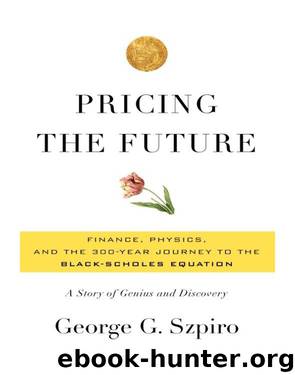Pricing the Future by George G. Szpiro

Author:George G. Szpiro
Language: eng
Format: epub
Publisher: Basic Books
Published: 2011-11-09T16:00:00+00:00
ELEVEN
Accounting for Randomness
I HAVE ALREADY ALLUDED TO THE MATHEMATICAL TECHNIQUES of calculus, that is, of differentiation and integration as formalized by Isaac Newton and Gottfried Wilhelm Leibniz. Bachelier was the first mathematician to bring calculus to bear on problems involving probability, Kolmogorov the most recent. But there was a problem. Simple calculus deals with smooth mathematical functions that are, for that reason, aptly called differentiable. Brownian motion, however, the linchpin for the understanding of financial markets, is jerky and jiggly and nowhere near smooth. This is why it is said to be “nondifferentiable.” In order to apply techniques from regular calculus to jerky processes, a new approach was required—stochastic calculus. The task to develop it fell on Kiyoshi Itō, our next pioneer in the search for the options pricing formula.
Born in 1915 in the Mie prefecture in southern Japan, Kiyoshi Itō studied mathematics at the Imperial University of Tokyo. As a student, he realized that random phenomena are governed by statistical laws. But this was before Kolmogorov had put probability on a sound footing, and Itō was not happy with the state of the field. “Although I knew that probability theory was a means of describing such phenomena, I was not satisfied with contemporary papers or works on probability theory, since they did not clearly define the random variable, the basic element of probability theory,” he wrote many years later. Itō, like his contemporaries, intuitively understood that a random variable referred to measurement results of a random experiment. But the lack of a formal definition made it difficult to work with so vague a notion. Like most mathematicians of his time, Itō regarded probability theory, as it was practiced then, as not quite serious. Upon graduation in 1938, he joined the Cabinet Statistics Bureau. It must have been a cushy job because—like Albert Einstein in the Swiss patent office—Itō had time on his hands. Apparently the bureau’s director realized that the young man could do more important things than just compile statistics and he allowed Itō enough leisure to study Kolmogorov ’s and Lévy’s works in depth. During his five years at the Cabinet Statistics Bureau Itō wrote the paper that would make random processes amenable to calculus. Entitled “On Stochastic Processes,”1 the paper was published in the Japanese Journal of Mathematics in 1942, three years before Itō obtained his doctorate.
Before we consider Itō’s contribution, let’s return for a moment to Brownian motion. Recall that microscopic particles suspended in a liquid are constantly being pushed around by the liquid’s molecules. Bombarded from all sides in this manner, the particles’ movements become so jagged that the resulting paths are nowhere near smooth; not even the most minuscule stretch of the path is straight. This is what had bedeviled the Nobel Prize–winning chemist The Svedberg when he tried to measure the particles’ speed. All he wanted to do was to measure a portion of a particle’s path and divide this length by the time the particle needed to traverse it. But he could never get a grip on the length.
Download
This site does not store any files on its server. We only index and link to content provided by other sites. Please contact the content providers to delete copyright contents if any and email us, we'll remove relevant links or contents immediately.
International Integration of the Brazilian Economy by Elias C. Grivoyannis(57292)
The Radium Girls by Kate Moore(10903)
Turbulence by E. J. Noyes(7033)
Nudge - Improving Decisions about Health, Wealth, and Happiness by Thaler Sunstein(6629)
The Black Swan by Nassim Nicholas Taleb(6184)
Pioneering Portfolio Management by David F. Swensen(5600)
Rich Dad Poor Dad by Robert T. Kiyosaki(5140)
Zero to One by Peter Thiel(4818)
Man-made Catastrophes and Risk Information Concealment by Dmitry Chernov & Didier Sornette(4730)
Secrecy World by Jake Bernstein(3774)
Millionaire: The Philanderer, Gambler, and Duelist Who Invented Modern Finance by Janet Gleeson(3566)
Skin in the Game by Nassim Nicholas Taleb(3456)
The Age of Surveillance Capitalism by Shoshana Zuboff(3413)
The Money Culture by Michael Lewis(3277)
Skin in the Game: Hidden Asymmetries in Daily Life by Nassim Nicholas Taleb(3259)
Bullshit Jobs by David Graeber(3173)
The Dhandho Investor by Mohnish Pabrai(3162)
The Wisdom of Finance by Mihir Desai(3069)
Blockchain Basics by Daniel Drescher(2884)
